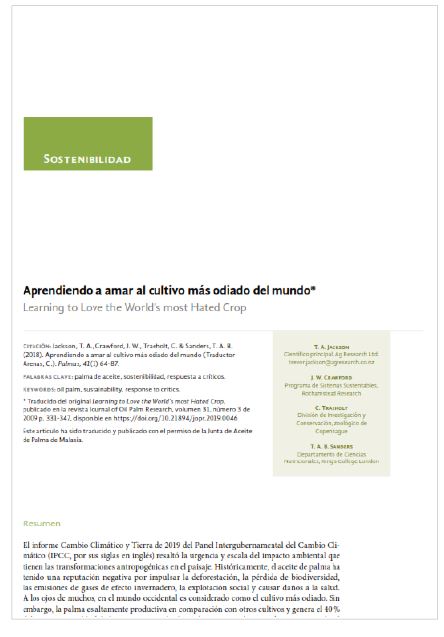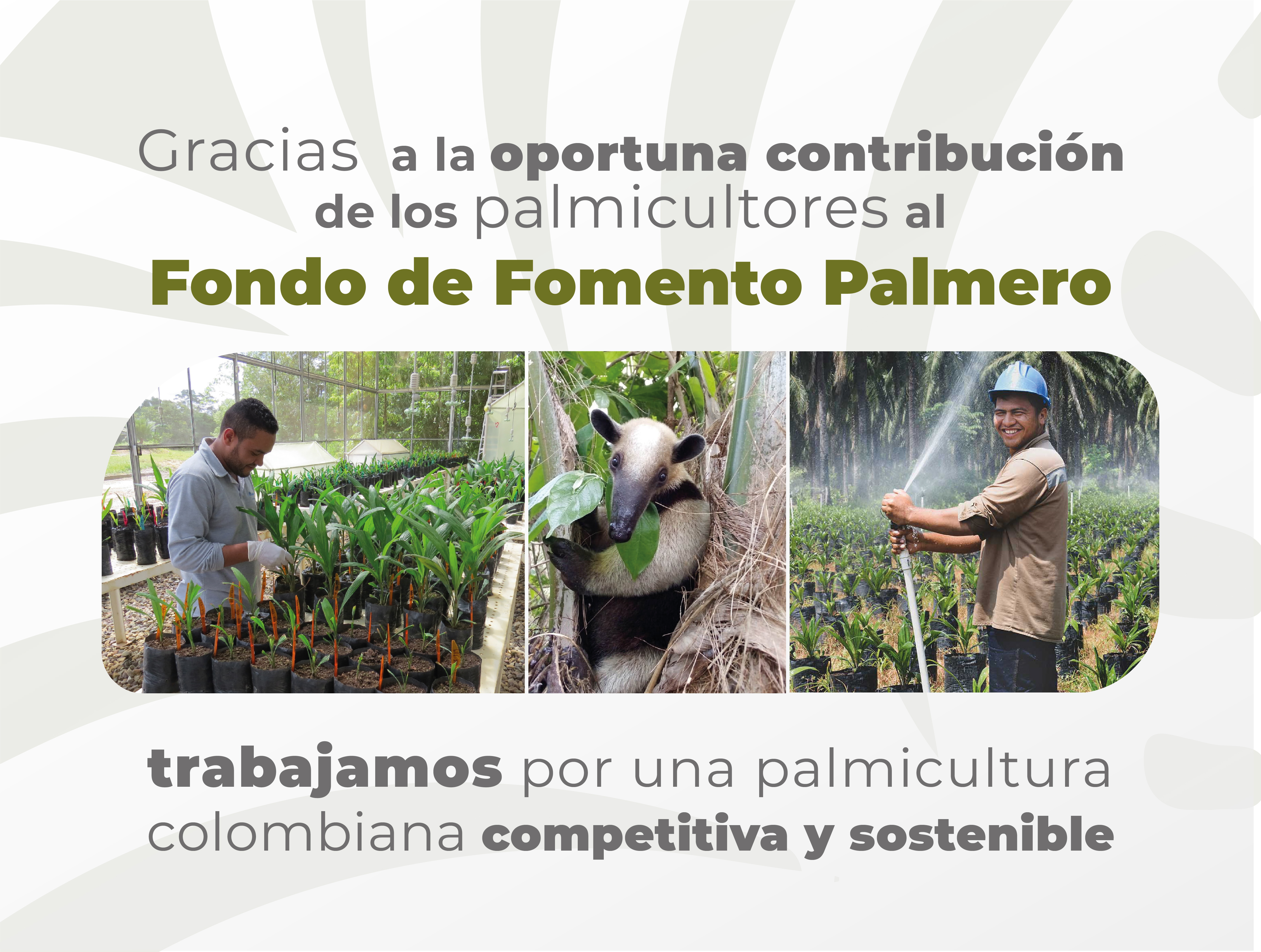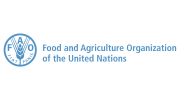Aprendiendo a amar al cultivo más odiado del mundo
Palabras clave:
palma de aceite, sostenibilidad, respuesta a críticosResumen
El informe Cambio Climático y Tierra de 2019 del Panel Intergubernamental del Cambio Cli- mático (IPCC, por sus siglas en inglés) resaltó la urgencia y escala del impacto ambiental que tienen las transformaciones antropogénicas en el paisaje. Históricamente, el aceite de palma ha tenido una reputación negativa por impulsar la deforestación, la pérdida de biodiversidad, las emisiones de gases de efecto invernadero, la explotación social y causar daños a la salud. A los ojos de muchos, en el mundo occidental es considerado como el cultivo más odiado. Sin embargo, la palma es altamente productiva en comparación con otros cultivos y genera el 40 % del aceite comestible del planeta con tan solo el 5 % de tierras productoras de aceite vegetal y el 0,4 % del total de tierras agrícolas. Tiene el potencial de satisfacer la demanda futura de aceite con mínimo impacto ambiental y climático en comparación con otras fuentes de aceite vegetal.
La densidad de alto valor relacionada tiene el potencial de sacar a millones de pequeños productores agrícolas de la pobreza. Dadas las conclusiones del informe Cambio Climático y Tierra del IPCC, es importante reexaminar la reputación de este cultivo a la luz de la evidencia acumulada y entender adecuadamente todos los impactos que tiene en factores ambientales, sociales, económicos y de salud. En este artículo se presenta una crítica integral de los beneficios y riesgos del cultivo en estas dimensiones y se proporciona una nueva síntesis. Se concluye que aunque la palma de aceite ha tenido un impacto negativo en el hábitat y la biodiversidad, juega un papel menor en comparación con la caza furtiva, la tala ilegal y las amenazas del cambio climático. Hay oportunidades importantes para que la industria reverse este daño. Su reputación negativa frente a la salud no está sustentada por evidencia científica y, de hecho, reemplazar algunos aceites en la dieta con aceite de palma puede ser benéfico. Los impactos económicos y sociales son más obvios en áreas en las que se han establecido economías de mercado adecuadas, pero puede haber impactos negativos significativos en áreas menos desarrolladas. También se concluye que gran parte de la reputación del aceite de palma no está basada en una interpretación equilibrada de la evidencia científica. Siempre y cuando los desarrollos futuros utilicen tecno- logías de captura de metano en las plantas de beneficio, empoderen a los pequeños productores indígenas, apoyen la regeneración de bosques secundarios y no impliquen deforestación ni ocurran en turba, concluimos que la palma de aceite puede ser el medio más sostenible ambiental, social y económicamente viable para satisfacer la demanda futura de aceite vegetal. De hecho, con colaboraciones proactivas con organizaciones no gubernamentales relevantes, la palma de aceite puede ser parte de la solución para reversar la degradación de los biomas de bosques tropicales.
Referencias bibliográficas
Ancrenaz, M., Wich, S., Meijaard, E. & Simery, J. (2016). Palm oil paradox: sustainable solutions to save the great apes. UNEP/GRASP, Nairobi. 57 pp. Recuperado de http://www.un-grasp. org/videos-resources/ publications/
Archer, S. A., Murphy, R. J. & Steinberger-Wilckens, R. (2018). Methodological analysis of palm oil biodiesel life cycle studies. Renewable and Sustainable Energy Reviews, 94, 694-704.
Bronsky, J., Campoy, C., Embleton, N., Fewtrell, M., Mis., N. F., Gerasimidis, K., Hojasak, I., Hulst, J., Indrio, F., Lapilionne, A., Molgaard, C., Moltu, S. J., Verduci, E., Vora, R. & Domelloh, M. (2019). Palm oil and beta-palmitate in infant formula: A position paper by the European Society for Pediatric Gastroenterology, Hepatology and Nutrition (ESPGHAN) Committee on Nutrition. J. Pediatr. Gastroenterol Nutr., 68(5), 742-760.
Canale, G. R., Peres, C. A., Guidorizzi, C. E., Gatto, C. A. F. & Kierulff, M. C. M. (2012). Pervasive defaunation of forest remnants in a tropical biodiversity hotspot. PLoS ONE,
7(8), e41671. doi:10.1371/journal.pone.0041671.
Chowdhury, R., Warnakula, S., Kunutsor, S., Crowe, F., Ward, H. A., Johnson, L., Franco, O. H., Butterworth, A. S., Forouhi, N. G., Thompson, S. G., Khaw, K. T., Mozaffarian, D., Danesh, J. & Di Angelantonio, E. (2014). Association of dietary, circulating, and supplement fatty acids with coronary risk: A systematic review and meta-analysis. Ann. Intern Med., 160(6), 398-406.
Colchester, M., Wee, A. P., Wong, M. C. & Jalong, T. (2007). Land is life: Land rights and oil palm development in Sarawak, report of the Forest Peoples’ Program and Sawit Watch. 136 pp. Recuperado de http://www. forestpeoples.org/en/topics/palm-oil-rspo/ publication/2010/land-life-land-rights-and-oilpalm-development-sarawak)
Corley, R. H. V. (2009). How much palm oil do we need? Environmental Science and Policy, 12(2), 134-139.
D’Andrea, A. C., Logan, A. L. & Watson, D. J. (2006). Oil palm and prehistoric subsistence in tropical West Africa. J. African Archaeology, 4, 1612-1651.
De Souza, R. J., Cozma, A. I., Ukeryk, E., Schunemann, H. & Anand, S. S. (2015). Intake of saturated and trans unsaturated fatty acids and risk of all-cause mortality, cardiovascular disease, and type 2 diabetes: Systematic review and meta-analysis of observational studies. BMJ., 351, h3978.
Dehghan, M., Mente, A., Zhang, X., Swaminathan, S., Wei, L. & Mohan, V. (2017). Prospective Urban Rural Epidemiology (PURE) study investigators. Associations of fats and carbohydrate intake with cardiovascular disease and mortality in 18 countries from five continents (PURE): A prospective cohort study. Lancet., 390(10107), 2050-2062.
Duckworth, J. W., Sankar, K., Williams, A. C., Samba Kumar, N. & Timmins, R. J. (2016). Bos gaurus. The IUCN Red List of Threatened Species 2016: e.T2891A46363646. doi: 10.2305/ IUCN.UK.2016-2.RLTS.T2891A46363646
Enström, A., Haatainen, T., Suharto, A., Giebels, G. & Kuan, L. Y. (2018). Introducing a new GHG emission calculation approach for alternative methane reduction measures in the waste water treatment of a palm oil mill. Environment, Development and Sustainability: 1-12. doi: 10.1007/ s10668-018-0181-4
FAO Statistical Databases (FAOSTATS). (2017). Food and Agriculture data. United Nations. Recuperado de www.fao.org
Fattore, E., Bosetti, C., Brighenti, F., Agostoni, C. & Fattore, G. (2014). Palm oil and blood lipid-related markers of cardiovascular disease: A systematic review and meta-analysis of dietary intervention trials. Am. J. Clin. Nutr., 99(6), 1331-1350.
Filippou, A., Teng, K. T., Berry, S. E. & Sanders, T. A. (2014). Palmitic acid in the sn-2 position of dietary triacylglycerols does not affect insulin secretion or glucose homeostasis in healthy men and women. Eur. J. Clin. Nutr., 68(9), 1036-1041.
Fassler,J.(2016). Giving up palm oil might actually be bad for the environment. Smithsonian Magazine March 2016. Recuperado de https://www.smithsonianmag.com/ science-nature/giving-up-palm- oil-might-actuallybe-bad-environment-180958092/, accessed on 28 April 2019.
Flynn, R. W. & Tajuddin Abdullah, M. (1984). Distribution and status of the Sumatran rhinoceros in Peninsular Malaysia. Biological Conservation, 28, 253-273.
Gaveau, D. L. A., Locatelli, B., Salim, M. A., Yaen, H., Pacheco, P. & Sheil, D. (2018). Rise and fall of forest loss and industrial plantations in Borneo (20002017). Conservation Letters, 2018, e12622. doi: 10.1111/conl.12622
Gaveau, D. L. A., Salim, M. & Arjasakusuma, S. (2016a). Deforestation and industrial plantations development in Borneo. doi: 10.17528/CIFOR/DATA.00049, Center for International Forestry Research (CIFOR), V2.
Gaveau, D. L. A., Sheil, D., Husnayaen, Salim, M. A., Arjasakusuma, S., Ancrenaz, M., Pacheco, P. & Meijaand, E. (2016b). Rapid conversions and avoided deforestation: Examining four decades of industrial plantation expansion in Borneo. Nature Scientific Reports: 32017. doi: 10.1038/srep32017.
Gibson, L., Lynam, A. J., Bradshaw, C. J. He, F., Bickford, D. P., Woodruff, D. S., Bumrungsri, S. & Laurance, W. F. (2013). Near-complete extinction of native small mammal fauna 25 years after forest fragmentation. Science, 341, 1508-1510.
Gilbert, N. (2012). Palm-oil boom raises conservation concerns. Nature, 487 (7405), 14-15. Ghazali, A., Asmah, S., Syafiq, M., Yahya, M., Aziz, N., tan, L., Norhisham, A. R. & Puan, L. (2016). Effects of monoculture and polyculture farming in oil palm smallholdings on terrestrial arthropod diversity. J. Asia Pac. Entomol., 19(2), 415-421.
Gingold, B. (2010). FAQ: Indonesia, degraded land and sustainable palm oil. World Resources Institute. Recuperado de http://www.wri.org/blog/2010/11/faqindonesia-degraded-landand-ustainable-palm-oil
Global Rainforest Watch. (2019). Recuperado de https://www. globalforestwatch.org/ Greenpeace (2018). The final countdown: Now or never to reform the palm oil industry. Recuperado de https://www. greenpeace.org/international/publication/18455/the-final-countdown-forests-indonesia-palm-oil/
Hamley, S. (2017). The effect of replacing saturated fat with mostly n-6 polyunsaturated fat on coronary heart disease: A meta-analysis of randomised controlled trials. Nutr. J.,16, 30. doi: 10.1186/s12937017-0254-5.
Havmøller, R. G., Payne, J., Widodo, R., Susie Ellis, Yoganand, K. Long, B., Dinerstein, E., Williams, A. C. Putra R. H., Gawi, J., Talukdar, B. K. & Burgess, N. (2016). Will current conservation responses save the critically endangered Sumatran rhinoceros Dicerorhinus sumatrensis? Oryx, 50(02), 355-359. doi:10.1017/s0030605315000472.
OIT. (2015). Promoting decent work on oil palm plantation in Indonesia. Recuperado de https://www.ilo.org/ jakarta/whatwedo/projects/WCMS_624552/lang-en/index.htm
OIT. (2017). Palm oil multi-stakeholder national dialogue. Recuperado de https://www.ilo. org/jakarta/ whatwedo/eventsandmeetings/WCMS_581467/ lang--en/index.htm
INPE (National Institute for Space Research, Brazil). (2019). Recuperado de https//terrabrasilis. dpi.impe.br/en/ homepage/
Kadandale, S., Marten, R. & Smith, R. (2019). The palm oil industry and non-communicable diseases. Bulletin of the World Health Organization 2019, 118-128.
Kanniah, K. D. Muhamad, N. & Kang, C. S. (2014). Remote sensing assessment of carbon storage by urban forest. International Symposium on Digital Earth, 26-29 August 2013, Kuching, Sarawak, Malaysia. IOP Conf. Series: Earth and Environmental Science, 18: 012151.
Kenney, J., Allendorf, F. W., McDougal, C. & Smith, J. L. D. (2014). How much gene flow is needed to avoid inbreeding depression in wild tiger populations? Proc. R. Soc. B., 281, 20133337. doi: 10.1098/rspb.2013.3337
Kretzschmar, P., Kramer-Schadt, S., Ambu, L., Bender, J., Bohm, T., Ernsing, M., Goritz, F., Hermes, R., Payne, J., Schaffer, N., Thayaparan, S. T., Zainal, Z. Z., Hilderbrandt, T. B. & Hofer, H. (2016). The catastrophic decline of the Sumatran rhino (Dicerorhinus sumatrensis harrissoni) in Sabah: Historic exploitation, reduced female reproductive performance and population viability. Global Ecology and Conservation, 6, 257-275. doi:10.1016/j. gecco.2016.02.006.
Jonas, H., Abram, N. K. & Ancrenaz, M. (2017). Addressing the impact of large-scale oil palm plantations on orangutan conservation in Borneo: A spatial, legal and political economy analysis. 94 pp. London: IIED. Recuperado de http://pubs.iied.org/ pdfs/12605IIED.pdf
Koh, L. P. (2008). Can oil palm plantations be made more hospitable for forest butterflies and birds? J. Appl. Ecol., 45, 1002-1009.
Kho, L. K. & Jepsen, M. R. (2015). Carbon stock of oil palm plantations and tropical forests in Malaysia: A review. Singapore J. Tropical Geography, 249-268.
Kushairi, A., Meilina Ong-Abdullah, Balu Nambiappan, Elina Hishamuddin, Mohd Noor Izuddin Zanal Bidin, Razmah Ghazali, Vijaya Subramaniam, Shamala Sundram & Ghulam Kadir Ahmad Parveez. (Kanniah). (2019) Oil palm economic performance in Malaysia and R&D progress in 2018. J. Oil Palm Res., 31(2), 165-194.
Laurance, W. F., Camargo, J. L. C., Luizao, R. C. C., Laurance, S. G., Pimm, S. L., Bruna, E. M., Stouffer, G. B., Williams, J., Benitez-Malvido, H. L., Vasconcelos, K. S., Van Houtan, C. E., Zartman, S. A., Boyle, R. D., Andrade, A. & Lovejoy, T. E. (2011). The fate of Amazonian forest fragments: A 32-year investigation. Biological Conservation, 144, 56-67. doi: 10.1016/j. biocon.2010.09.021
Laurance, W. F. (2017). An Amazonian rainforest and its fragments as a laboratory of global change. Biological Reviews, 93(1), 223-247. doi:10.1111/ brv.12343
Marklund, M., Wu, J. H. Y., Imamura, F., Del Gobbo, L. C. Fretts, A., De Goede, J., Shi, P., Tintle, N., Wennberg, M., Aslibekyan, S., Chen, T. A., De Oliveira Otto, M. C., Hirakawa, Y., Eriksen, H. H., Kröger, J., Laguzzi, F., Lankinen, M., Murphy, R. A., Prem, K., Samieri, C., Virtanen, J., Wood, A, C., Wong, K., Yang, W. S., Zhou, U. X., Baylin, A., Boer, J. M. A., Brouwer, I. A., Campos, H., Chaves, P. H. M., Chien, K .L. De Faire, U., Djoussé, L., Eiriksdottir, G., El-Abbadi, N., Forouhi, N. G., Michael-Gaziano, J., Geleijnse, J. M. Gigante, B., Giles, G., Guallar, E., Gudnason, V., Harris, T., Harris, W. S., Helmer, C., Hellenius, M. L., Hodge, A., Hu, F. B., Jacques, P. F., Jansson, J. H., Kalsbeek, A., Khaw, K. T., Koh, W. P., Laakso, M., Leander, K., Lin, H. J., Lind, L., Luben, R., Luo, J., Mcknight, B., Mursu, J., Ninomiya, T., Overvad, K., Psaty, B. M., Rimm, E., Schulze, M. B., Siscovick, D., Skjelbo-Nielsen, M., Smith, A. V., Steffen, B. T., Steffen, L., Sun, Q., Sundström, J., Tsai, M. Y., Tunstall-Pedoe, H., Uusitupa, M .I. J., Van Dam, R. M., Veenstra, J., Monique- Verschuren, W-M, Wareham, N., Willett, W,. Woodward, M., Yuan, J. M., Micha, R., Lemaitre, R. N., Mozaffarian, D., Risérus, U., Cohorts for Heart and Aging Research in Genomic Epidemiology (CHARGE) Fatty Acids and Outcomes Research Consortium (FORCE). (2019). Biomarkers of dietary omega-6 fatty acids and incident cardiovascular disease and mortality. Circulation, 139(21), 2422-2436.
Meijaard, E. (2018). Oil palm and biodiversity. A situation analysis by the IUCN oil palm task force. IUCN Oil Palm Task Force Gland, Switzerland: IUCN. p. xiii, 16 pp.
Mensink, R. P., Sanders, T. A., Baer, D., Hayes, K. C., Howles, P. N. & Maranggoni, A. (2016). The increasing use of interesterified lipids in the food supply and their effects on health parameters. Adv Nutr., 7(4), 719-729.
Mickute, V. (2018). Palm oil threatens indigenous life in Malaysia. Recuperado de https://www. aljazeera.com/news/2018/08/palm-oil-threatens-indigenous-lifemalaysia-180817060716266. html
Morgans, C. L., Meijaard, E., Santika, T., Law, E., Budiharta, S., Ancrenaz, M. & Wilson, K. A. (2018). Evaluating the effectiveness of palm oil certification in delivering multiple sustainability objectives. Environ. Res. Lett., 13, 064032.
MPOB. (2018). Oil palm planted area 2018. Recuperado de http://bepi.mpob.gov.my/index. php/en/statistics/ area/189-area-2018/857-oil-palm-planted-area-asat-dec-2018.html
Miles, E. A. & Calder, P. C. (2017). The influence of the position of palmitate in infant. Nutr. Res., 44, 1-8.
Morrissy-Swan, T. (15 de noviembre de 2018). What is palm oil, where is it found, and how can you avoid it? The Telegraph. Recuperado de https://www. telegraph.co.uk/food-and-drink/ news/palm-oilfound-can-avoid.
Murphy, D. J. (2014). The future of oil palm as a global crop: Opportunities and challenges. J. Oil Palm Res., 26, 1-4.
Nesadurai, H. E. S. (2013). Food security, the palm oil land conflict nexus, and sustainability: A governance role for a private multi-stakeholder regime like the RSPO? The Pacific Review,
26, 505-529.
Paoli, G. D., Yaap, B., Wells, P. L. & Sileuw, A. (2010). CSR, oil palm and the RSPO: Translating boardroom philosophy into conservation action on the ground. Tropical Conservation Science, 3(4), 438-446.
O’Connell, A., Kousoulidou, M., Lonza, L. & Weindorf, W. (2019). Considerations on GHG emissions and energy balances of promising aviation biofuel pathways. Renewable and Sustainable Energy Reviews, 101, 504-515.
Petrenko, C. Paltseva, J. & Searle, S. (2016). Ecological impacts of palm oil expansion in Indonesia. ICCT: Washington D. C., USA. 28 pp.
Pye, O., Daud, R., & Harmono, Y. (2012). Precarious lives: Transnational boundaries of migrant oil palm workers. Asia Pacific Viewpoint, 53, 330-342.
Rietberg, P. & Slingerland, M. (2016). Barriers to smallholder RSPO certification. A science-for- policy paper by the SEnSOR programme. 38 pp.
Riutta, T., Malhi, Y., Kho, L. K., Marthews, T. R., Huasco, W. H., Khoo, M., Tan, S., Turner, E., Reynolds, G., Both, S., Burslem, D. F. R. P., Teh, Y. A., Vairappan, C., Majalap, N. & Ewers, R. (2018). Logging disturbance shifts net primary productivity and its allocation in Bornean tropical forests. Glob. Change Biol., 24, 29132928. doi: 10.1111/gcb.14068.
Rosoman, G., Shuen, S. S., Opal, C., Anderson, P. & Trapshah, R. (Eds). (2017). The HCS approach toolkit. Singapore: HCS Approach Steering Group. 28 pp. Recuperado de http://highcarbonstock.org/wp-content/ uploads/2017/05/HCSA-Toolkit-v2.0-Module-1Introduction-190917-web.pdf
RSPO. (2015). Free, prior and informed consent guide for RSPO members. 123 pp. Recuperado de https://rspo.org/ news-and-events/announcements/free-prior-andinformed-consent- guide-for-rspo-members-2015endorsed
RSPO. (2017). Formation of the RSPO Labour Rights Task Force (LTF). https://rspo.org/news- andevents/announcements/formation-of-the-rspolabour-rights-task-force-ltf, accessed on 30 April 2019.
RSPO. (2018). Principles and criteria for the production of sustainable palm oil. 91 pp. Recuperado de https://ga.rspo.org/ ga15/Resolutions/RSPO_P&C_2018.pdf
RSPO. (2019). Transforming Markets to Make Sustainable PalmOil the Norm. 10 pp. Recuperado de https://rspo.org/about
Sabah Government. (2018). Sabah Forest Policy. 60 pp. Recuperado de http://www.forest.sabah. gov.my/images/ pdf/publications/DH-Sabah.2018.pdf
Santika, T., Kerrie, A. W., Budiharta, S., Law, E. A., Poh, T. M. Ancrenaz, M., Struebig, M. & Meijaard, E. (2019). Does oil palm agriculture help alleviate poverty? A multidimensional counterfactual assessment of oil palm development in Indonesia. World Development, 20, 105-117.
Sasidhran, S. (2016). Habitat occupancy patterns and activity rate of native mammals in tropical fragmented peat swamp reserves in Peninsular Malaysia. For. Ecol. Manage., 363, 140-148.
Stibig, H. J. (2014). Change in tropical forest cover of Southeast Asia from 1990 to 2010. Biogeosciences, 11, 247-258.
Stichnothe, H. & Schuchardt, F. (2011). Life cycle assessment of two palm oil production systems. Biomass and Bioenergy, 35, 3976-3984.
Sun, G., Xia, H., Ma, S., Zhou, H., Shu, G., Wang, S., Yang, X., Wang, F., He, Y., Ding, R., Yin, H., Wang, Y., Yang, Y. & Yang, L. (2018). Effects of palm olein and olive oil on serum lipids in a Chinese population: A randomized, double-blind, cross-over trial. Asia Pac. J. Clin. Nutr., 27(3), 572-580.
Todaro, M. P. & Smith, S. C. (2009). The environment and development. Economic Development. Essex: Pearson Education Limited. p. 483-529.
Topani, R. (1990). Status and distribution of tiger in Peninsular Malaysia. J. Wildlife Parks (Malaysia), 9, 71-102.
Tullis, P. (10 February 2019). How the world got hooked on palm oil? The Guardian. Recuperado de https:// www.theguardian.com/news/2019/feb/19/palmoil-ingredient-biscuits-shampoo- environmental.
The Star. (2019). Palm oil awareness starts with Malaysians. The Star, 9.
Union of Concerned Scientists (UCS). (2013). Palm oil and global warming. Cambridge, MA. 5 pp. Recuperado de https://www.ucsusa.org/sites/default/files/ legacy/assets/documents/
global_warming/palmoil-and-global-warmingpdf
Voigt, M., Serge, A. W., Ancrenaz, M., Meijaad, E., Abram, N., Banes, G. L., Campbell- Smith, G., D’arcy, L. J., Delgado, R. A., Erman, A., Gaveau, D., Goossen, B., Heinicke, S., Houghton, M., Husson, S., Leiman, A., Sanchez, K. L., Makinuddin, N. & Kuhl, H. S. (2018). Global demand for natural resources eliminated more than 100.000 Bornean orangutans. Current Biology, 28, 761-769.
Wich, S. A., Gaveau, D., Abram, N., Ancrenaz, M., Baccini, A., Brend, S., Curran, L., Delgado, R. A., Erman, A., Fredriksson, G. M., Goossens, B., Husson, S. & Lackman, L. (2012). Understanding the impacts of land-use policies on a threatened species: Is there a future for the Bornean orangutan? PLoS ONE, 7(11), e49142.
Wich, S. A., Meijaard, E., Marshall, A. J. & Husson, S. (2008). Distribution and conservation status of the orangutan (Pongo spp.) on Borneo and Sumatra: How many remain? Oryx,
42(3), 1-11.
World Bank. (2018). Land area (sq km). Recuperado de https://data. worldbank.org/indicator/
ag.lnd.totl.k2
WWF. (2018a). Position statement: Why palm oil boycotts are not as helpful as they might seem. 2 pp. Recuperado de http://d2ouvy59p0dg6k.cloudfront.net/ downloads/wwf_position_
on_po_boycott_ november_2018.pdf
WWF. (2018b). Sabah Forest Policy 2018. A step forward in Sabah’s environmental conservation. 2 pp. Recuperado de https://wwf.panda.org/knowledge_hub/where_we_ work/borneo_forests/?341254/Sabah-Forest-Policy2018-A-Step-Forward-in-Sabahs-environmentalConservation
Yan, N. W. (2017). A makeover for the world’s most hated crop. Nature, 543, 306-308.















